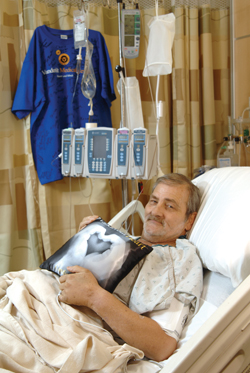
A novel surgical technique helped keep patient Thomas Johnson’s heart pumping while he waited for a transplant. (photo by Neil Brake)
Heart procedure buys precious time
Steven Hoff, M.D.
The clock was ticking on Thomas Johnson's ticker.
The 55-year-old patient from Clarksville had suffered multiple heart attacks that left his heart muscle severely damaged. A heart transplant was his only hope for survival and he had been on the waiting list for a year when he arrived at the Vanderbilt Heart & Vascular Institute on Oct. 29.
As he lay in bed in the Cardiovascular Intensive Care Unit (CVICU), he suffered continuous arrhythmia — nearly 100 episodes in a five-hour period.
His surgeon, Steven Hoff, M.D., assistant professor of Cardiac Surgery, used a novel approach to buy his patient time while he awaited a heart transplant.
He placed an intra-aortic balloon pump in the axillary artery under Johnson's collar bone to help increase blood flow to Johnson's heart and relieve the stress on it.
Balloon pumps are typically inserted through the groin via a catheter and pushed up through the artery to the heart.
The drawback to this approach is the patient has to lie flat on his back so as not to cause a kink in the line, which affects the blood flow.
“Being bedridden doesn't make you a good transplant recipient, because the longer you're in bed, the more debilitated you get, the weaker you become,” Hoff said.
“If Mr. Johnson got a new heart, being immobile would complicate his recovery because his overall condition before the transplant would be worse.”
Also, Johnson has the most common blood type — O — which means he could have been waiting months or years for a heart transplant.
With the axillary balloon pump in place, Johnson was able to walk around the CVICU and eventually worked up to eight laps a day. One month after arriving at Vanderbilt, he received the good news that a donor heart had been found.
He received the transplant on Nov. 30, his mother's birthday. His recovery was uneventful, and he was discharged last week.
Johnson is the third Vanderbilt patient to receive the intra-aortic balloon pump in the axillary artery in the last few months.
“This technique is one of several examples of new and innovative procedures we're now able to offer at Vanderbilt,” Hoff said.
“New procedures such as this will help put Vanderbilt Heart at the forefront of cardiac care nationally.”
Because Johnson was in the CVICU for a month, he and his family became well-acquainted with the doctors and nurses.
“I had Thanksgiving dinner in the hospital room with my family. I had four of my nurses who came in and ate with me.
“They are like family now,” a grateful Johnson said.
His daughter, Jennifer Hayes, and wife, Marcha, emphasized the need for more awareness surrounding organ donation.
Neither had signed their organ donor cards prior to Johnson's transplant.
Now they both have, and they want to spread the word on the need for others to do so.
“If it weren't for the donor, my father's story would not have the happy ending that it does,” Hayes said.













